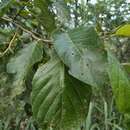pt-BR
nomes no trilho de navegação


Alnus formosana (lat. Alnus formosana) - tozağacıkimilər fəsiləsinin qızılağac cinsinə aid bitki növü.
Alnus formosana (lat. Alnus formosana) - tozağacıkimilər fəsiləsinin qızılağac cinsinə aid bitki növü.
Alnus formosana, the Formosan alder, is a species of alder endemic to Taiwan.[1] It is a medium-sized tree, up to 20 metres (66 ft) in height[2] and 40 centimetres (16 in) in trunk diameter.[3]
The formosan alder is a trees up to 20 meters in height with dark gray-brown bark. The petiole is 1.2-2.2 cm, slender; leaves elliptic or oblong-lanceolate, rarely ovate-oblong, 6-12 × 2–5 cm, hairy in the axils of lateral veins beneath, almost hairless above, rounded or broadly cuneate base, irregularly minutely serrated margin, acuminate or acute apex; lateral veins 6 or 7 on each side of the midrib. It has one female inflorescence, or 2-4 in a cluster, ellipsoid, 1-2.5 cm; peduncle 3–5 mm.[2]
It is found in Taiwan. It is a common species growing on riverbanks from near sea level to 2,900 metres (9,500 ft).[2] It is commonly found in disturbed habitats as a pioneer species.[3]
Alnus formosana flowers between May–June, fruiting between July–September.[2]
This tree is used for soil improvement.[3] It also finds use in gardens and as a windbreak. The tree trunks is also used in paper pulping and cultivating snow fungus and shiitake.[4]
The Atayal people uses A. formosana as a cover crop after clearing a new field, the traditional wisdom being that the soil becomes rich when it is cut cleared again in 10 to 15 years.[3][5] It is also used in the Pas-ta'ai ritual of the Saisiyat people.[6]
Early Han settlers of Taiwan name some places after the occurrence of the plant, the belief being that its occurrence is linked to ground collapse.[7]
Alnus formosana, the Formosan alder, is a species of alder endemic to Taiwan. It is a medium-sized tree, up to 20 metres (66 ft) in height and 40 centimetres (16 in) in trunk diameter.
Alnus formosana[1], eða Formósuölur, er elritegund frá Tævan. Þetta er meðalstórt tré, að 20m hátt. Hann er algeng tegund á árbökkum frá sjávarmáli upp í 2900 m.h.yfir sjávarmáli.[2]
Alnus formosana (Burkill) Makino, Bot. Mag. (Tokyo). 26: 390. 1912. Alnus maritima (Marshall) Nuttall var. Formosan Burkill in FB Forbes and Hemsley, J. Linn. Soc., Bot. 26: 500. 1899; A. japonica (Thunberg) Steudel var. Formosan Callier. Trees up to 20 m in height; dark gray-brown bark. Purplish brown branches, glabrous, grooved; barely pubescent twigs. Stipitate outbreaks, with 2 scales glabrous vaults. Petiole 1.2-2.2 cm, slender pubescent, densely furrow; Elliptic or oblong-lanceolate Limbo, rarely ovate-oblong, 6-12 × 2–5 cm, abaxially bearded in axils, lateral veins adaxially subglabrous, rounded or broadly cuneate base, irregularly minutely serrated margin, acuminate or acute apex; lateral veins 6 or 7 on each side of the midrib. One female inflorescence, or 2-4 in a cluster, ellipsoid, 1-2.5 cm; peduncle 3–5 mm, robust; bracts 3–4 mm, woody, cuneate base, rounded apex 5-lobed. Nutlet obovate, 2–3 mm, papery wings 1 / 4-1 / 3 as wide as nutlet. Fl. May–June, fr. July–September
Alnus formosana, eða Formósuölur, er elritegund frá Tævan. Þetta er meðalstórt tré, að 20m hátt. Hann er algeng tegund á árbökkum frá sjávarmáli upp í 2900 m.h.yfir sjávarmáli.
Alnus formosana là một loài thực vật có hoa trong họ Betulaceae. Loài này được (Burkill) Makino mô tả khoa học đầu tiên năm 1912.[1]
Alnus formosana là một loài thực vật có hoa trong họ Betulaceae. Loài này được (Burkill) Makino mô tả khoa học đầu tiên năm 1912.
臺灣赤楊(學名:Alnus formosana)又稱臺灣榿木、臺北赤楊、水柳柯、水柯仔等,為樺木科赤楊屬下的植物。
世界分布於琉球及臺灣,於臺灣廣泛分布於本島低海拔至 3000 公尺處,常會形成小塊的純林,多生於溪流兩旁、河谷、第二期森林,或有充足陽光照射之崩塌地開墾地,為森林演替之先驅物種。
於赤楊的根部可發現有固氮能力之根瘤,所以能夠於相對貧瘠的土地上生長。而赤楊屬均為多倍體,繁殖策略為以量致勝,因此能適應各種不同的環境,以得健壯速生的後代[1]。
臺灣赤楊為落葉性喬木,樹高可達 20 公尺,徑可達 40 公分,樹皮暗灰褐色,小枝光滑無毛,或於幼時略被短柔毛。
葉互生,為單葉,葉形橢圓形至卵狀長圓形,長 6~12 公分,寬 2~5 公分,先端漸尖,基部寬楔形,葉緣細鋸齒狀,中肋及側脈於近軸面凹下而於遠軸面突起,側脈 6~7 對,部份側脈直達葉緣之鋸齒,其餘側脈則在抵達葉緣前朝先端彎曲;葉柄細,長約 1.5~2.5 公分。
花為單性,雌雄同株,雄花序著生於小枝先端,為下垂的葇荑花序,其苞片為菱形至圓形,內含 3 枚雄花,雄花含雄蕊 4 枚;雌花序著生於老枝先端,為短穗狀花序,苞片 5 裂,先端圓形,且木質化,長約 3~4 毫米,內有 2 枚雌花,沒有花被片,雌花有雌蕊 1 枚,花柱 2 枚,子房 2 室,每室含 1 枚胚珠。花期自秋天至隔年春天。
果序呈毬果狀,由雌花序發育而來,果梗(原雌花序花梗)長約 1.5 公分,1~3 個橢圓形果序著生於果枝上;木質苞片殘存,堅果小而扁平,有狹窄的翅,內含 1 枚種子,頂部有殘存的花柱。
於環境方面,赤楊的根部有根瘤菌固氮,所以能夠改善土壤品質[1];在種植方面,除了可作為庭植觀賞樹種或防風樹之外,也因為它是能夠於崩塌地生長的陽性先驅樹種,所以在造林和水土保持上也很重要;於經濟層面,其木材可供作紙漿,或作為栽培香菇或白木耳的段木[2]。
除了上述功能,赤楊也與原住民的傳統文化有所關聯,如泰雅族的祖先遺訓謂於墾殖三年後栽植赤楊,10~15 年後再耕,土壤便會再次肥沃[1][3]、賽夏族的矮靈祭所使用的送靈儀式所使用的木材[1][4]等。
而赤楊也有關於俗名的故事,如其中之一的水柯仔,早期來臺開墾的漢人以柯仔林為地名,因為赤楊能夠生長於崩塌地的特性,多少有警示崩塌可能於此處發生的意味[5]。